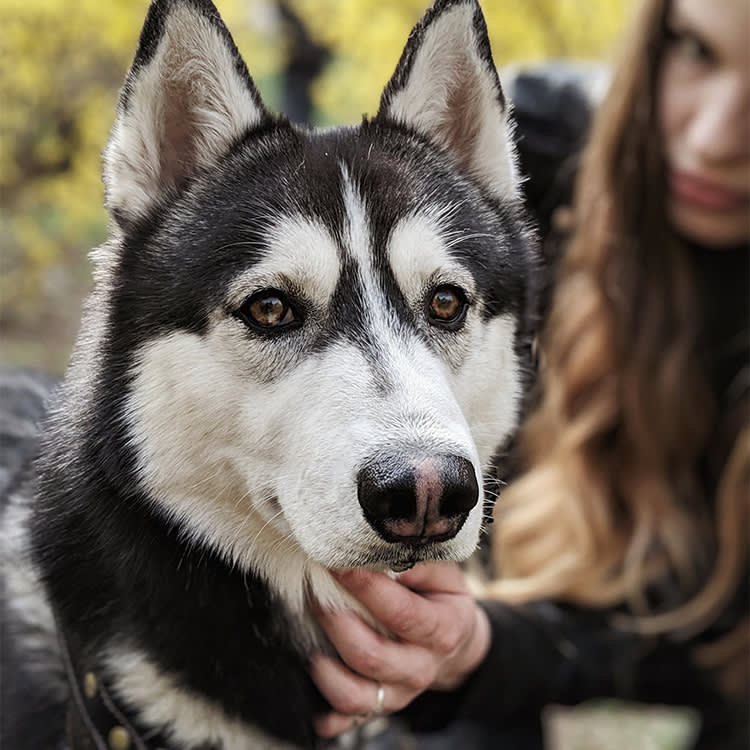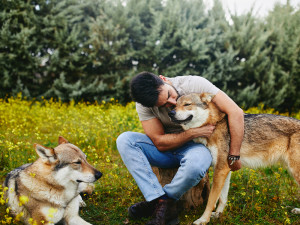The Debate on Canine Domestication
Your dog’s origin story.
Researchers have identified the origin of cattle, horses, pigs, sheep, camels, ducks, chickens, cats, and goats. But the genesis of the domestic dog, our oldest companion and the most varied, numerous and widely distributed domestic animal on the globe? We’re still trying to figure out that one.
Traditionally, scientists relied on observations of differences in stable physical traits like teeth, skulls, and sometimes fossils. Now, genome-wide comparisons have been used to provide detailed information about the evolution of the dog.
Save on the litter with color-changing tech that helps you better care for your cat.
Dogs as a species
Let’s start with the basics:
The species of the dog is Canis lupus familiaris.
The genus of the domestic dog is Canis.
They belong to the Canidae family, which includes wolves, jackals, foxes, and dogs.
What makes dogs unique is that they exhibit the most variability in shape, size, behavior, and temperament of any mammal species living on Earth. About one billion dogs, a population larger than any other domestic subspecies, roam the globe. Canine fossils, some dating to as long ago as 36,000 years, are found on every continent except Antarctica.
Add to that the unusual phenomenon that extreme variation can occur in as little as one generation — a sort of evolution at hyper speed. Then, we begin to understand why classifying domestic dogs has challenged many of the taxonomical systems that have been used to make sense of Canidae.
The history of dogs
Historically, as far back as the fourth century BCE, theories of the descent of animals were the product of using philosophical approaches to relate organic life to the history of time. At first, fundamental ideas about species-change involved sorting out living beings by means of their common essential properties. Philosophers wanted to know how organic life forms were related, not where they came from.
Early Ideas
The Greek philosopher Aristotle (384–322 BCE) endorsed the idea that natural beings were always here and always would be. He commented on the dog’s origin, not in respect to the animal’s continuous chronological past but rather, in terms of breed creation. In his view, the dog that nature created was bred to the fox to make small dogs and to bears to make big ones, perhaps making the point that breeds (although he was mistaken about cross-species hybridization) were created by humans. Still, in the Aristotelian view, dogs always existed.
The Middle Ages
As time went on, the earliest naturalists came to understand that species were related in more complicated ways, and began to devise orderly classification systems. The bigger picture of life, however, was explained within a theological context: a specific act of an omnipotent creator transformed all living things whole and complete. The revolutionary notion that every animal might not be a singular divine creation didn’t materialize until the late Middle Ages, a contradiction that had to be explored hypothetically to avoid conflict with religious doctrine.
In the 16th-century English cleric Edward Topsell (1572–1625), author of The History of Four-Footed Beasts, whose worldview was defined by fire-and-brimstone religion, based his categories on morality. This was not as much of a stretch as it might seem from today’s vantage point; during Topsell’s time, people had real reason to fear wolves. For them, the predatory wolf and sagacious, noble dog provided excellent examples of two moral extremes. Domesticated farm livestock had derived from prey species, and no other large predator had (or has) been domesticated. So, it seemed illogical that the gentle, devoted dog could have evolved from the wolf.
19th Century
As Darwin later observed, if organic beings didn’t possess an inherent tendency to vary, humans could do nothing. Unlike bears and lions, wolves, for reasons still scientifically unclear, possessed the variation necessary for the creation of the multiple hundreds of dog breeds recognized today.
Imagine how frustrating it must have been to try to make sense of how dogs were related and where they came from based on their appearance. Travel the world over and a cat will usually look like a cat, but dogs were a vexing contradiction.
The origin of dogs
In the Americas, many dogs were likely Old World breeds introduced by European explorers, eventually returned to a feral state. Over time, they interbred with American Indian dogs, wolves and coyotes, defaulting to pariah-type dogs — a catchall term for semi-feral, free-ranging canines. But a misunderstanding of the distinct differences between wild, tame, domestic, and feral dogs added to the confusion about how Canidae should be classified.
Darwin (1809–1882) believed that the dog had multiple origins: from wolves, jackals, and at least one South American species. He supported the latter by referencing his observations of dogs in Patagonia who swam underwater and an unusual dog he had seen in Central America. He also advanced the idea of multi-regional domestication. Darwin further imagined that these small populations of “inferior” native dogs were eventually supplanted by the incursion of more robust dogs introduced by Europeans, an analogy he used to demonstrate the idea of “survival of the fittest.”
Evolutionary process
Although the fundamental theory of origin is attributed to Darwin, other taxonomists previously proposed similar ideas and connections, including Jean-Baptiste Lamarck and Alfred Russel Wallace. Unlike Lamarck and Wallace, however, Darwin suggested that the evolutionary process occurred through natural selection.
Although Darwin used the breeding of dogs as analogies to explain how natural selection worked, dogs continued to be an untidy group of animals — a puzzle that science has began to unlock by the use of genome-wide sequencing. Once scientists discovered methods to explore the dogs’ origin at the molecular level, they began to test these historical theories.
How dogs evolved
The evolution of dogs involved a process called domestication. The real question is when did this domestication process take place? And that’s been up for debate among scientists.
Differences of opinion erupted and criticism of research methodologies undermined a delicately balanced collaboration process. Numerous studies argued for canine origin in places as diverse as East Asia, Mongolia, Siberia, Europe and Africa, with timing varying from somewhere between 15,000 and 135,000 years ago. Researchers struggled to find common ground, but without much success.
As early as the 1970s, research papers were published suggesting that dogs may have been derived from several different gray wolf populations, and that canine domestication may have happened much earlier than the fossil record’s 15,000 years ago.
Did European hunters tame the first dogs?
In 2013, when UCLA evolutionary biologist Robert Wayne and his team published a comprehensive set of data suggesting that dogs evolved from a group of European wolves, now extinct, somewhere between 19,000 and 32,000 years ago.
Or did the first dogs come from East Asia?
In 2015, Peter Savolainen, a molecular biologist, and his colleagues at the Royal Institute of Technology in Stockholm published convincing resultsopens in new tab indicating that dogs originated in China, south of the Yangtze River. They estimated that this dog population split from wolves 33,000 years ago.
Why not both?
Both teams were sequencing DNA. Why were their findings literally all over the map? While Savolainen and his colleagues worked backward in time, Wayne’s group worked forward, tracking ancient DNA collected from prehistoric bones of wolves and wolf-like dogs, then measuring decreasing genetic diversity. As DNA becomes less diverse, it points to animals transitioning from wolves to dogs. A dead end indicates that a lineage became extinct in that particular region.
Although the two studies point in very different directions, Savolainen and Wayne may both be right. It’s possible that dogs were domesticated multiple times in different regions, and that most lineages died out when humans were faced with overwhelming challenges, like climate change. Their findings aren’t mutually exclusive.
Crunching the (very big) numbers
In 2016, researchers suggested that all these claims may be right. A team of scientists compared genetic data with existing archaeological evidence and found that dogs may have emerged independently from two separate (possibly now extinct) wolf populations that lived on opposite sides of the Eurasian continent. This means that dogs may have been domesticated not once, as widely believed, but twice. The results of their analyses demonstrate a genetic separation between modern dog populations currently living in East Asia and Europe.
The ongoing search to understand where, when and how many times dogs were domesticated continues to be a topic of active scholarly exploration. Besides the millions of dog lovers who are curious about the roots of our affectionate and unusual cross-species relationship, substantial scientific issues are at stake, issues that may profoundly alter the future of evolutionary theory.
FAQs
When did dogs first appear?
Dogs first appeared approximately 15,000 to 30,000 years ago, with the earliest dog fossils being from the Bonn-Oberkassel site in Germany, dating back around 14,000 years.
Where did dogs originate from?
Researchers found that dogs originated from wolves and their domestication likely took place in multiple regions, including Europe and Asia.
How long have dogs been around?
Dogs have been around for approximately 15,000 to 30,000 years, with their domestication dating back to ancient times.
What are dogs’ ancestors?
The ancestors of dogs are wolves — specifically, gray wolves. Through domestication thousands of years ago, wolves evolved into the domestic dog we know today.
Was Dogor a dog or a wolf?
An 18,000-year-old wolf puppy nicknamed “Dogor” frozen in the Siberian permafrost was uncovered with its fur, nose, mouth and even its whiskers intact.
References:
Freedman, Adam H., and Robert K. Wayne. “Deciphering the Origin of Dogs: From Fossils to Genomes.” Annual Review of Animal Biosciences, vol. 5, no. 1, 8 Feb. 2017, pp. 281–307, https://doi.org/10.1146/annurev-animal-022114-110937opens in new tab.
Lord, Kathryn, et al. “Evolution of Working Dogs.” Cambridge University Press, Cambridge University Press, 2016, www.cambridge.org/core/books/abs/domestic-dog/evolution-of-working-dogs/CC5083D37F741470DDFA69AFBB238AB1opens in new tab.
Price, Michael. “Ancient Wolves Give Clues to Origins of Dogs.” Www.science.org, 29 June 2022, www.science.org/content/article/ancient-wolves-give-clues-origins-dogsopens in new tab.
Randall, Keith. “Study Finds 5 Distinct Dog Types from 11,000 Years Ago.” Texas A&M Today, 29 Oct. 2020, today.tamu.edu/2020/10/29/study-finds-5-distinct-dog-types-from-11000-years-ago/opens in new tab. Accessed 10 Feb. 2025.
Siberia: 18,000-Year-Old Frozen “Dog” Stumps Scientists. 28 Nov. 2019, www.bbc.com/news/world-europe-50586508opens in new tab.
“The Evolution of Dog Breeds Now Mapped.” ScienceDaily, 2017, www.sciencedaily.com/releases/2017/04/170425124855.htmopens in new tab.









